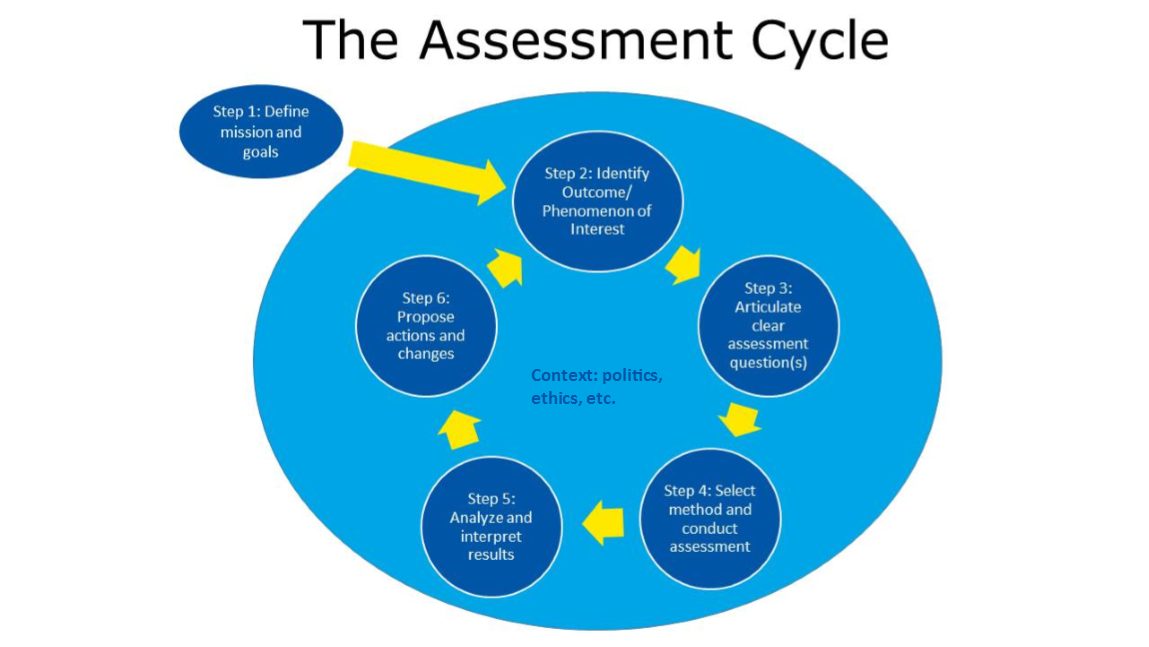
Planning to conduct an assessment? Not sure where to begin?
In addition to formal consultation and assessment planning support, SAIRO has compiled resources that provide guidance about how to design and administer effective assessments at every step. More specific information about Baseline can be found here. Review the steps below to find a variety of topics throughout the assessment cycle, including quantitative and qualitative assessment topics, as well as advice on project planning, data analysis, using Baseline as well as reporting. Some resources are printable reference pages, while others are parts of presentations we've facilitated in the past. You can go in order by clicking each step or jump to whatever step your project needs.
Step 1: Define Mission and Goals
What am I trying to find out?
Designing a good assessment is an art, and doing it well requires some reflection before you begin. These resources are designed as guides for the very first step of assessment, offering three key questions to think about as you get started as well as a step by step roadmap for how to begin.
Step 2: Identify Outcome or Phenomenon of Interest
What are you trying to learn about?
An outcome is a clearly defined idea that is likely focused on students or programs and services and reflects measurable goals. Outcomes matter in assessment because they help you know if you are meeting big picture goals, and help you to understand how the topic you are assessing fits into your department as well as in Student Affairs.
For some projects (such as Annual Reports), currently existing Student Affairs wide outcomes are very useful. Below you’ll find information on creating your own outcomes, as well as information on using Student Affairs Outcomes. Learn more about Divisional Coordination of Assessment.
Step 3: Articulate Clear Assessment Question(s)
What specific questions guide your assessment?
Assessment questions are essentially the purpose of your assessment in question form. They are derived from clearly stated objectives that flow from the program’s overall goals. Effective assessment questions are a direct reflection of the purpose of the assessment, are appropriate to the specific outcomes of a given program or service and can be answered realistically in a measurable way. Here are some resources to help you get started.
Does the data already exist?
This stage is also a good point to take stock as to what kind of information your questions cover. Before collecting new data, it can be valuable to identify what data already exists, what topics are covered, and their location. SAIRO may also already have existing data that can be used in your assessment too.
To find out if data already exists and how to request it, check out the Reports and Data section.
Step 4: Select Method and Conduct Assessment
What is the best way to gather the data?
Designing the right kind of assessment method is an essential part of creating a useful assessment, and often involves lots of tweaking. For some questions, a quantitative approach is best but in other cases a qualitative approach might be required. Other projects might require a mixed method approach. Use these guides as well as the planning checklist as a resource to help you determine what kind of assessment is right for your project and how to design for what you need. You can also contact us at SAIRO if you are not sure how to proceed.
For information on crafting surveys:
- Writing Effective Survey Questions
- Designing Effective Surveys
- Common Pitfalls to Good Survey Design
- Survey Planning Checklist
For information on Quantitative Methods:
For information on Qualitative Methods:
Step 5: Analyze and Interpret Results
What does it all mean?
Once you have gathered all your data, the next step is to analyze and interpret your results. For whatever methodology you choose for your assessment, there are many ways to examine the information you gathered. You don’t have to be a math whiz to analyze your data. Baseline has many features built in that can help you interpret your data. Here are some resources to get you started.
Step 6: Propose Actions and Changes
How can I share and use my findings and decide how to proceed?
Once you have your results, it can be challenging to figure out the best way to analyze and present the information. You might want to share your results with others, and use them to guide future decisions related to the program or outcome you assessed. Here are some resources that will help you share your results in effective and illuminating ways.
Start Again at Step 2: Identify Specific Outcome or Phenomenon of Interest
